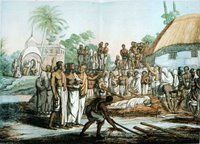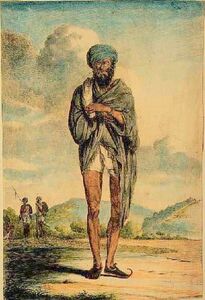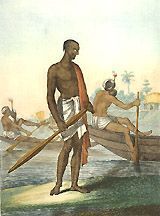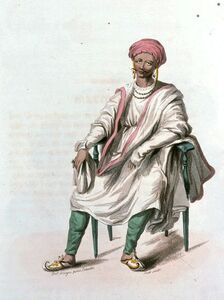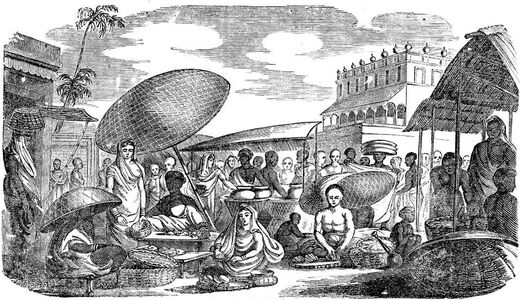In Calcutta, the Daniells, Thomas and his nephew Williams were well known. Subho Tagore, particularly promoted them. He had a large collection of their work and they became the main characters in the center of the stage. The Victoria Memorial also housed The Daniells and there were frequent exhibition of their works. The Daniells were a household word.That Kumar was to add the large elephantine folio to the collection of the Memorial, at a much latter date, is another story. Solvyns was practically unknown then in Calcutta. Kumar , discovered some plates of Solvyns in the Catalogue of Bernard Quaritch in late 60’s and added them to his collection. He then started a definitive hunt for Solvyn’s complete works and was able to acquire a set of the Hinddos, printed in Calcutta, some time latter. From here he started promoting Solvyn’s work in a great way. He went out of his way to persuade collectors, friends and aficionados to collect Solvyns. But who is Solvyns?
As a young artist in the Austrian Netherlands, Francois Balthazar Solvyns had been under the patronage of the Hapsburg governors,but political upheaval in 1789 soon left him adrift, and in 1790, he set sail for India to seek his fortune. From the 1760s onwards, India, and Calcutta particularly, had begun to attract European professional artists. By 1791, when Solvyns arrived in Calcutta, a number of painters, of varying talents, had already spent time in Bengal. The most prominent were Tilly Kettle, John Zoffany, William Hodges, and Thomas and William Daniells.
Where Kettle and Zoffany largely pursued portraiture in painting nabobs and nawabs, British merchant-officials and Indian princes, Hodges and the Daniells portrayed India in its natural beauty and ‘scenic splendors’. It was for Solvyns to portray Indians, the people of this fabled land in their customs, manners, and dress, in their occupations and festivals.In his early years in Calcutta, Solvyns worked as something of a journeyman artist and was even employed for a time in decorating coaches and palanquins, but in 1794, he announced his plan for A Collection of Two Hundred and Fifty Coloured Etchings: Descriptive of the Manners, Customs and Dresses of the Hindoos. The collection was published in Calcutta in a few copies in 1796, and then in greater numbers in 1799. Divided into twelve parts, the first section, with 66 prints, depicts ‘the Hindoo Casts, with their professions’. The sections following thereafter portray servants, costumes, means of transport (such as carts, palanquins, and boats), modes of smoking, fakirs, musical instruments, and festivals.
The project proved a financial failure. The etchings, by contemporary European standards, were rather crudely done, and they did not appeal to the vogue of the ‘picturesque’. In 1803, Solvyns left India for France and soon redid the etchings for a lavish folio edition of 288 plates, Les Hindoûs, published in Paris between 1808 and 1812 in four volumes. Even these sumptuous volumes failed commercially, victim to the unrest of the Napoleonic wars and to the sheer cost of the publication. When the Kingdom of the Netherlands was formed in 1814, Solvyns returned to his native Antwerp, where William I appointed him Captain of the Port in recognition of his accomplishments as an artist.
Solvyns died in 1824. Solvyns’s life is fascinating in itself, whereas his portrayal of India constitutes a rich visual account of the people of Bengal in the late ghteenth century. The prints proper are of importance in a tradition reaching back to the early seventeenth century, and even earlier than that, with encyclopaedic efforts to represent systematically both the unfamiliar, as in costumes of foreign lands, and the familiar, as in the typologies of peasants, craftsmen, and street vendors. In portraying the Hindus, however, Solvyns is not simply recording ethnographic types. He gives his figures individual character and places them in time and space, with narrative interest, and in doing so, he provides the viewer intimate access.
This separates him from purely encyclopaedic interest, as he combines the ethnographic and the aesthetic with artistic purpose. He conveys ‘art as information’. As an artist, Solvyns provided a prototype for the genre of ‘Company School’ paintings of occupations, done by Indian artists for the British that became popular in the early nineteenth century. But more significantly from an historical and social perspective,’s work Solvyns, with its accompanying descriptions, constitutes the first ‘ethnographic survey’ of India or more precisely of Bengal. Moreover, with his ordered, hierarchical portrayal of Hindu castes in Bengal, however problematic this may be, may well Solvyns be the first European to provide a systematic ranking of castes. Yet this contribution has never been recognized. Historians and anthropologists have rarely drawn upon for an Solvyns understanding of society in Bengal in the late eighteenth century.


